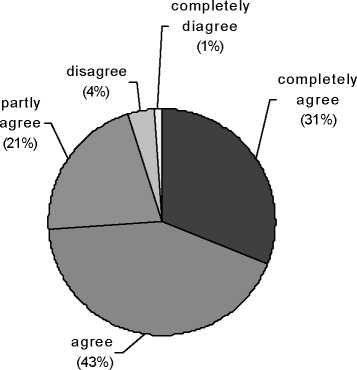Network management and organizational structure
For a network to function successfully, it is crucial that it have sound management, and
effective organizational structures for information exchange and decision-making. In the
initial phase, management is of central importance for the InnoRegio concept. Assessing
management and organizational structures thus offers further criteria with which the level of
development can be judged. It is again necessary for a suitable form of organization to tailor
itself to actual conditions in the network. Due to the lack of an objective measurable indicator,
the views of network participants once again have to be used in the assessment.
The management assessment was carried out using the categories “positive influence on the
network”, “leadership ability” and “confidence in the management”. The majority of
participants gave the management a positive assessment using these criteria. Only a few
were dissatisfied (Figure 4). The assessment was also scaled. The range was between 3.6
and 4.4. Every sixth network diverges by at least 0.2 percentage points above or below the
mean for all other networks (4.0) respectively. This is classified as having an above average
positive or negative value respectively.
Figure 4
Participant rating of the network
management 2001
"The management efficiency and
leadership qualities are positive for
the network. "

Source: DIW Berlin and partners, questionnaire
from summer 2001.
DIW Berlin 2002
11
More intriguing information
1. Confusion and Reinforcement Learning in Experimental Public Goods Games2. The Structure Performance Hypothesis and The Efficient Structure Performance Hypothesis-Revisited: The Case of Agribusiness Commodity and Food Products Truck Carriers in the South
3. Do imputed education histories provide satisfactory results in fertility analysis in the Western German context?
4. Bidding for Envy-Freeness: A Procedural Approach to n-Player Fair Division Problems
5. RETAIL SALES: DO THEY MEAN REDUCED EXPENDITURES? GERMAN GROCERY EVIDENCE
6. Artificial neural networks as models of stimulus control*
7. Comparative study of hatching rates of African catfish (Clarias gariepinus Burchell 1822) eggs on different substrates
8. LAND-USE EVALUATION OF KOCAELI UNIVERSITY MAIN CAMPUS AREA
9. Consumption Behaviour in Zambia: The Link to Poverty Alleviation?
10. ISSUES IN NONMARKET VALUATION AND POLICY APPLICATION: A RETROSPECTIVE GLANCE